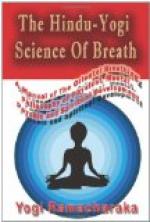In imperfect or shallow breathing, only a portion of the lung cells are brought into play, and a great portion of the lung capacity is lost, the system suffering in proportion to the amount of under-oxygenation. The lower animals, in their native state, breathe naturally, and primitive man undoubtedly did the same. The abnormal manner of living adopted by civilized man—the shadow that follows upon civilization—has robbed us of our natural habit of breathing, and the race has greatly suffered thereby. Han’s only physical salvation is to “get back to Nature.”
CHAPTER IV.
THE ESOTERIC THEORY OF BREATH.
The Science of Breath, like many other teachings, has its esoteric or inner phase, as well as its exoteric or external. The physiological phase may be termed the outer or exoteric side of the subject, and the phase which we will now consider may be termed its esoteric or inner side. Occultists, in all ages and lands, have always taught, usually secretly to a few followers, that there was to be found in the air a substance or principle from which all activity, vitality and life was derived. They differed in their terms and names for this force, as well as in the details of the theory, but the main principle is to be found in all occult teachings and philosophies, and has for centuries formed a portion of the teachings of the Oriental Yogis.
In order to avoid misconceptions arising from the various theories regarding this great principle, which theories are usually attached to some name given the principle, we, in this work, will speak of the principle as “Prana,” this word being the Sanskrit term meaning “Absolute Energy.” Many occult authorities teach that the principle which the Hindus term “Prana” is the universal principle of energy or force, and that all energy or force is derived from that principle, or, rather, is a particular form of manifestation of that principle. These theories do not concern us in the consideration of the subject matter of this work, and we will therefore confine ourselves to an understanding of prana as the principle of energy exhibited in all living things, which distinguishes them from a lifeless thing. We may consider it as the active principle of life—Vital Force, if you please. It is found in all forms of life, from the amoeba to man—from the most elementary form of plant life to the highest form of animal life. Prana is all pervading. It is found in all things having life, and as the occult philosophy teaches that life is in all things—in every atom—the apparent lifelessness of some things being only a lesser degree of manifestation, we may understand their teachings that prana is everywhere, in everything. Prana must not be confounded with the Ego—that bit of Divine Spirit in every soul, around which clusters matter and energy. Prana is merely a form of energy used by the Ego in its material manifestation. When the Ego leaves




